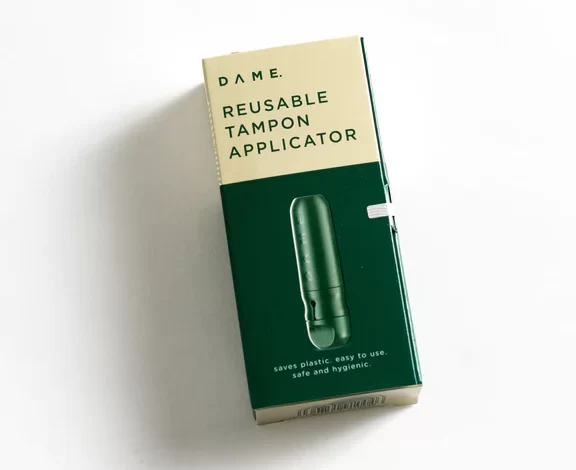Washable sanitary tampons, the future of menstrual protection?

Are you, like many women, a fan of disposable tampons but torn by your conscience?
She is right in this awareness, it has now been proven that the disposable tampon, although a basis of feminine hygiene, is not your body’s friend. Or the planet for that matter!
But at the same time, it’s so comfortable and practical.
Indeed, it has many advantages: it is invisible, it does not bother you when you urinate, you can go in the water with it, you throw it in the nearest trash can or directly in the toilet (which is very serious) and life goes on. These benefits are unfortunately to be weighed against the effects produced on (or rather in) your body as well as the well-being of the planet.
We are not here to put disposable tampons on trial, but the lack of transparency from manufacturers as to the materials used does not inspire complete confidence in this product.
To get an idea, we invite you to watch this interview with Audrey Gloaguen, the director of the documentary “Tampon, Notre ennemi in time”, broadcast on France 5 on April 25, 2017.
That’s why today we want to do a little factual description of washable sanitary tampons to try to convince you of the power of this new mode of menstrual protection.
First of all, what is a washable tampon?
For the moment the examples are quite limited because there is only one brand present in this market! This is ImseVimse, an innovative Swedish brand which, since its creation in 1988, has offered sustainable and clean hygienic solutions for women and children.
In 2016, ImseVimse had the brilliant idea of creating a dame reusable tampon applicator, following on from the washable sanitary napkins (SHL) and cups that the company was already offering. After extensive research and a 6-month test on several women, convinced of the performance of this new product, the brand markets it.
We, therefore, thank ImseVimse for this genius idea: 2 layers of cotton, sewn together and then rolled to look like a “conventional” tampon. It’s simple, it’s effective!
To complete the whole thing and make it easier to hold, put on and take off the tampon, a simple string to wrap around and let protrude the desired length.
But how does tampon work in practice?
We’ve all played in a long, really long phone call or Zoom meeting at rolling a little piece of paper up on itself. It’s the same principle for the washable pad. Simply roll up the strip of fabric tightly and wrap the string around it to hold it in place.
Here we dissect the different steps: the 1st photo shows the strips of fabric ready to roll. There are three sizes to best match your body type and flow.
Then the 2nd presents the stamp being rolled.
And the last represents the penultimate step: the tampon is rolled up, ready to be tied by the string.
At the end of the winding, it looks just like your traditional disposable tampon (but this one is 100% clean).
All you have to do is insert it deep into your vagina. You can let the string stick out or insert it as well, it’s up to you. It will always be possible to recover it with your fingers for removal.
Once in place, if you feel any discomfort, it is badly positioned. He knows how to be forgotten or he will find his place, this must be your criterion to be serene!
In case of vaginal dryness, you may have difficulty inserting it because it is dry and has no applicator. To remedy this, it is possible to coat it with a thin layer of natural vegetable oil (coconut oil, St. John’s wort oil, sweet almond oil, or even olive oil).
For removal, you can gently pull the string or reach for the base of the tampon with your fingers (the best position for this is squatting with your legs apart). And you can use your perineum to gently lower the tampon.
And then what do I do?
That’s a very good question. And that’s really where the novelty in using washable tampons lies.
Normally, when removing a disposable tampon…you throw it away. It’s all in the name.
But in our case, we keep it, it is in the interest of the washable/reusable. But what to do with this blood-soaked cloth pad?
There are several scenarios depending on where you are.
Blockages: wow, menstrual blood, I don’t put my hands in it!
Like all reusable protection, the washable dame reusable tampon applicator implies that you are comfortable with blood and more particularly with menstrual blood. Indeed, disposable protections, by definition, do not require washing and often the contents are not even looked at. If you want to move towards washable protection, you will necessarily have to “get your hands in it”!
Our society has always considered menstrual blood as dirty, impure and to be hidden to respect good morals! Fortunately today the word is free and it is becoming less and less taboo.
To get used to it, and thus switch more easily to washable solutions, you can already start looking at this blood. At each cycle, before throwing your pad or tampon, observe it. Also, read articles on the subject: understand your periods, and your menstrual cycle, to live them better!
Then, try buying washable protection: a towel, a tampon, a cup or menstrual panties. Take the test on a quiet day at home. Put it there and go about your life as usual.
In the case of the tampon, try different positions for insertion and removal, get used to it and be reassured of the effectiveness of the protection. Then, wash it following the steps mentioned above. You have time, the process can be more or less long, it all depends on you. Remember, the sooner you switch to reusable protection, the sooner your body, the planet and your wallet will thank you!
Your periods are normal and healthy, it’s a part of a woman’s life, and there’s nothing to be ashamed of!
Why are washable tampons good?
There are 3 main reasons
The first is economic: having your period costs money!
We of course confirm the entire demonstration ( the very good article in Le Monde explains everything in detail). A menstruating woman spends an average of €3,800 on protection during her lifetime. Switching to durable protection saves a lot of money over a long period. For example, the box of 8 washable tampons – normal flow – ImseVimse costs €22.95. The most comfortable is to have two boxes, so no downtime after washing/drying. The estimated lifespan of washable tampons is 10 years, knowing that a woman is menstruating for 40 years on average, so 8 boxes would be needed to cover this entire period. So 8 boxes at 22.95 = €183.60. For more comfort, you can add the purchase of one or two menstrual panties for the night.
The second reason is ecological: menstrual protection produces waste, a lot of waste.
According to the book, Flow: The Cultural Story of Menstruation, the average woman throws away between 100 and 150 kg of pads, tampons and applicators in her lifetime. Of course, at the time, we don’t realize it, but 1 stamp + 1 stamp +… that’s a lot of stamps after all.
Also, pads like disposable tampons are not recyclable which means they are either incinerated or landfilled. And unfortunately, the chemical materials and the plastic present in the protection, it’s packaging, it’s overwrapping, and its applicator permanently pollutes the soil and waterways and take an average of 500 years to degrade. 500 years of pollution for a few hours of use is waste that hurts…
Making the transition to sustainable sanitary protection, therefore, makes it possible to take a giant step for the planet and move towards a zero waste objective.
“Last but not least”: The last reason which is also the most important is your health.
The tampon is an intravaginal device which means that it is placed in your vagina which is one of the most sensitive areas of your body. It deserves special attention. Each complication related to this area can have very serious consequences and affect the rest of your life. It is therefore necessary to take great care of your vagina and its hygiene!
Unfortunately, manufacturers do not seem very concerned about this, as explained in the article by 60 million consumers. We learn in particular that the tampons contain traces of phthalates (a chemical product used as a plasticizer and which acts on fertility and the development of the fetus), BPS and BPA ( bisphenol A and S which interact with the functioning of humans), dioxins and other petrochemical additives or residual pesticides, including the famous glyphosate.
As the protections are in direct contact with the skin or mucous membranes, the presence of these substances can cause irritation and allergies. The main problem is the longer term: most of the substances mentioned above are also known to be endocrine disruptors. They are very often associated with various ailments such as certain cancers, hormonal dysfunctions and reproductive problems.
A very small object, although useful, can permanently ruin your life, think about it!
The use of washable tampons is not free of all risks of course.
The conclusion of tampons that still responds to the answer of the title
Last very very important recommendations:
Before the first use washes the fabrics in the machine or puts them in boiling water for a few minutes to sterilize them. Let dry and presto they are usable!
Every time you use, touch, handle or even think of your tampon, you MUST have clean hands. Your hands are the main channel for spreading germs and other bad microbes to your body. You touch a sensitive part, extremely irrigated and fragile. You must therefore put the odds on your side to avoid complications. Clean hands are the sinews of war!
Change protection regularly (every 4 hours maximum), especially if they are intravaginal!
Don’t sleep with your tampon on all night. Prefer external protection: towel or cotton menstrual panties suitable for the night.
To know which buffer size to choose, know your flow: light, normal or super. Depending on the flow, the size of the fabric strip to be rolled will be larger or smaller. The larger the strip, the thicker the roller stamp will be.
Take care of your stamp when washing to preserve its lifespan.
Find our washable tampons as well as accessories and soaps to make your life easier!




